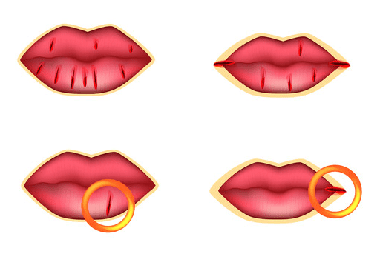Dermatology >>>> Cracked lips
Cracked lips.

A cracked lip is a chronic condition that can occur at any age and in both sexes. As a rule, a single crack (furrow) of varying depth appears, which is located transversely to the red border of the lips. In most cases, a crack occurs on the lower lip, in its central part or slightly from the side, it can continue to the mucous membrane from the inner side of the lip, but does not pass to the skin. During the night, a shallow crack can heal, epithelize, but in the morning it cracks again when the lip moves and begins to bleed. It happens that over time, the cracks on the lips become covered with a brown crust and swelling, inflammation forms along their perimeter. The edges of the crack are compacted and keratinized, becoming covered with a whitish-gray bloom.
Without proper treatment, a crack on the lip can exist for many years, in some cases it periodically heals, after a while it reappears.

A pathological examination of the lip crack reveals chronic inflammation, hyperplastic, metaplastic or regenerative growths of the epithelium.
The etiology of the disease is not well understood. It is believed that the formation of lip cracks is facilitated by the anatomical features of the structure of the lip and chronic trauma resulting from several factors:
- The surrounding atmosphere or lack of moisture in the body causes the red border of the lips to dry out,
- Violation or loss of elastic properties of the lip tissues leads to tears,
- Hypovitaminosis vitamins A and trigger structural changes in lip tissue,
- Pathogenic microflora that has colonized the oral cavity or facial skin can cause inflammation and prevent the crack from healing.
Treatment of cracks on the lips requires finding out the reason for the chronicity of this process. The treatment is based on ointments containing antibiotics, ointments with corticosteroids, epithelizing, healing agents (sea buckthorn oil, rosehip oil, Shostakovsky balm), vitamin therapy with high doses of vitamins A, PP, group B (especially B2 and B6). If conservative treatment does not give an effect, surgical treatment is used - the elements of the crack are excised within the healthy tissue. There is always a need to treat a crack, since an advanced chronic process can lead to precancerous formations on the lip and lip cancer.

Read

Read



























